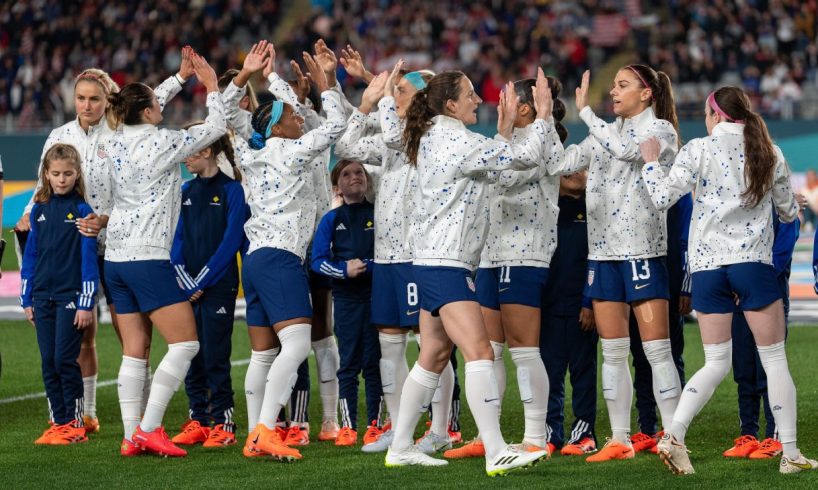
As the U.S. women’s national team continue their campaign to win their fifth Women’s World Cup, there’s one aspect of this tournament that feels different from all the previous ones: The USWNT aren’t fighting with their bosses for better pay.
During and after winning in 1991, 1999, 2015 and 2019, the USWNT were embroiled in protests and boardroom arguments about being paid comparable compensation to their male counterparts. The issue came to a head at the previous World Cup in France when the USWNT lifted the trophy and fans at Stade de Lyon chanted, “Equal pay! Equal pay!”
But this time around, it’s a fight that USWNT aren’t involved in. Instead, we see it within teams Canada, England, Jamaica, Nigeria and South Africa, where players are fighting with their federations over a lack of equal pay and equal support compared with their male counterparts.
So why aren’t the USWNT talking and campaigning for equal pay this time around? And how much money will they earn during this World Cup? Read on.
– Women’s World Cup: Home | Squads | Fixtures | Podcast
Who decides how much money the USWNT can get for winning the World Cup?
There are two different governing bodies that oversee the USWNT: the U.S. Soccer Federation, which is essentially the USWNT’s employer, and then FIFA, the world governing body of soccer that hosts the Women’s World Cup. Money from both entities has an effect on how the USWNT get paid for playing in a World Cup.
First, the USWNT have a labor contract with U.S. Soccer. That collective bargaining agreement determines how much USWNT players get paid for all international soccer duties: national team camps, friendlies, Olympics, World Cups and even off-field work like public appearances.
Second, FIFA awards prize money to each team competing in the Women’s World Cup. That money is distributed to federations (such as U.S. Soccer), who can then distribute a portion of the prize money to the players or, if they want, all of it. The bonuses that U.S. Soccer offers players for their performances in the Women’s World Cup have traditionally been based mostly — but not entirely — on FIFA prize money.
For this Women’s World Cup, FIFA is offering a total of $150 million, compared to $440 million for the Men’s World Cup last summer. The winners of the women’s tournament, still to be decided Aug. 20, will win $4.3 million for their federation from FIFA, while Argentina won $42 million in the men’s tournament last year. The last-place men’s team earned $9 million, while the last-place women’s team will earn $1.6 million.
If FIFA isn’t offering equal prize money now, will they in the future?
Maybe. FIFA President Gianni Infantino has said FIFA hopes to offer equal prize money but he has been noncommittal, dangling that possibility as a way to spur broadcasters to pay more for the rights of the tournament.
Editor’s Picks
2 Related
“Our ambition is to have equality in payments for the 2026 Men’s and 2027 Women’s World Cup,” Infantino told the FIFA Congress in March. “This is the objective that we set to ourselves. FIFA is stepping up with actions, not just with words. But unfortunately this is not the case of everyone across the industry. Broadcasters and sponsors have to do more. FIFA is receiving between 10 and 100 times inferior offers for the Women’s World Cup.
“These same public broadcasters who are paid by taxpayers’ money, they criticise FIFA for not guaranteeing equal pay to men and women. You pay us 100 times less, [but] your viewing figures are similar.”
As an aside: The irony is that FIFA itself cheapened the value of the Women’s World Cup for years by offering it as a free add-on for broadcasters bidding for the rights to the men’s tournament. The 2023 is the first time the Women’s World Cup was sold separately to broadcasters as a standalone tournament.
So why were the USWNT fighting with U.S. Soccer over equal pay?
The USWNT sought the same compensation that the U.S. men’s team earned and, after much fighting and back-and-forth, U.S. Soccer was generally willing to equalize bonus payments — except for when it came to the World Cup. Citing the drastic differences FIFA paid out for the men’s and women’s tournament, U.S. Soccer said it couldn’t make up that shortfall on its own.
In the previous cycle, per their contract with U.S. Soccer, the U.S. men could earn up to around $30 million as a team depending on how they performed at the World Cup. The women, on the other hand, could earn a maximum of $6 million for their World Cup performance. Although these were bonuses paid out by U.S. Soccer, the federation said they were based on how much prize money FIFA would award for the two tournaments.
The USWNT sued in 2019, seeking $67 million in back pay — largely the amount the players would’ve gotten for winning two World Cups under the men’s contract.
The federation fought it both on a legal front and a public relations front. U.S. Soccer President Cindy Parlow Cone said that offering the same World Cup bonuses to the women “would likely bankrupt the Federation.”
How did the USWNT get equal pay with U.S. Soccer if FIFA money is still unequal?
Last year, U.S. Soccer, the women’s national team and the men’s national team came together for a historic and first-of-its-kind deal: The two teams would pool their FIFA prize money together and then split it equally among both teams. Although FIFA prize money is still unequal, the teams have chosen to split it equally.
For instance, the U.S. men won around $13 million from FIFA for reaching the round of 16 at the World Cup in Qatar last year. If the women suffer a historic early exit and get knocked out in the round of 16 of this ongoing Women’s World Cup, they would win around $1.9 million. But after pooling that money together with the men’s money, and after giving 10% to U.S. Soccer to support youth programs, the USWNT would actually receive around $6.7 million, which will be more money than FIFA will award the champion of this tournament ($4.3 million).
No other federation splits money in this way. The Australian national teams, for instance, have proclaimed that they have equal pay down to the cent, but the caveat is that the agreement doesn’t include FIFA prize money. That’s the case with every equal pay deal around the world, except in the United States.
So, no matter where the USWNT finishes in this Women’s World Cup, they will take home more in prize money than any other team. Even if the USWNT had gotten knocked out in the group stage, they’d earn over $6 million as a team, while the champion can win only $4.3 million.
Thus, there’s no reason for the USWNT to fight with U.S. Soccer about money anymore.






